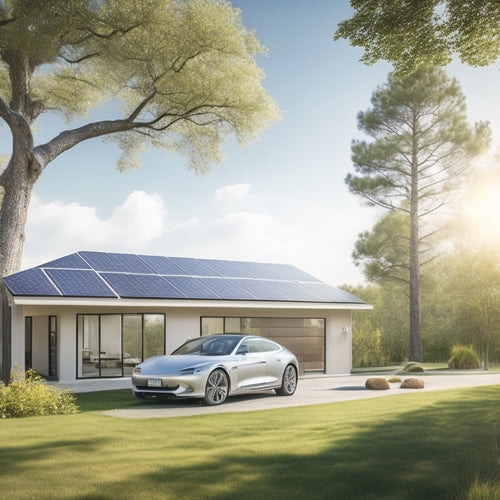
Solar Panel Solutions for a Sustainable Future
Share
As you shift to a cleaner and more sustainable energy future, embracing solar panel solutions is essential for reducing your reliance on fossil fuels and mitigating the environmental impact of your energy consumption. You'll benefit from improved photovoltaic technology, increased accessibility to renewable energy education, and investment in solar energy systems that contribute to a significant reduction in carbon footprint. With advancements in bifacial and thin-film solar cells, energy storage, and grid integration, you'll be able to utilize renewable energy efficiently. Now, you're on the cusp of revealing a sustainable future - and there's more to investigate in the world of solar panel solutions.
Key Takeaways
- Solar energy innovations, like bifacial cells and thin-film technology, increase energy output and reduce costs, making sustainable power sources more accessible.
- Grid-scale energy storage solutions, including pumped hydro and lithium-ion batteries, stabilize power supply and enable seamless integration with solar panels.
- Cost-effective solar panel systems, with financing options and government incentives, make renewable energy adoption more affordable for commercial and residential users.
- Solar energy leads to a significant reduction in greenhouse gas emissions, serving as a clean and renewable power source with minimal landfill waste and eco-friendly manufacturing.
- Continued growth in solar investment, driven by demand and cost reduction, is expected to make solar power a dominant global energy source by 2030.
Harnessing Renewable Energy Sources
You're likely aware that the world is shifting towards cleaner, more sustainable power sources, and for good reason. As the global energy environment evolves, it's vital to utilize renewable energy sources that reduce our reliance on fossil fuels.
You're probably interested in exploring innovative solutions that can energize your daily life while minimizing environmental impact.
Solar energy innovations have revolutionized the way we generate power. With advancements in photovoltaic technology, solar panels have become more efficient and affordable. Renewable energy education has also become more accessible, enabling individuals to make informed decisions about their energy choices.
By investing in solar energy systems, you can notably reduce your carbon footprint and contribute to a cleaner environment.
To fully utilize the potential of renewable energy sources, it's imperative to stay updated on the latest developments and breakthroughs. Staying informed about solar energy innovations and renewable energy education can help you make the most of sustainable power solutions.
Reducing Carbon Footprint Effectively
As you invest in solar energy systems, reducing your carbon footprint becomes a tangible reality. By integrating solar panels into your daily life, you're taking a significant step towards minimizing your environmental impact. However, there's more to reducing your carbon footprint than just utilizing renewable energy. You can further offset your carbon emissions by implementing lifestyle adjustments and carbon offset strategies.
| Lifestyle Adjustments | Carbon Offset Strategies | Impact |
|---|---|---|
| Reduce energy consumption | Invest in reforestation projects | 10-15% decrease in carbon footprint |
| Use eco-friendly transportation | Purchase carbon credits | 5-10% decrease in carbon footprint |
| Implement recycling programs | Support renewable energy projects | 15-20% decrease in carbon footprint |
| Conserve water resources | Invest in energy-efficient appliances | 5-10% decrease in carbon footprint |
| Reduce food waste | Participate in local sustainability initiatives | 10-15% decrease in carbon footprint |
Solar Panel Technologies Advancements
You're likely aware that solar panel technologies have made considerable progress in recent years.
Advancements in bifacial solar cells, for instance, have enabled energy harvesting from both the front and back sides of a panel.
In addition, thin-film efficiency gains and the emergence of perovskite solar cells are set to revolutionize the industry.
Bifacial Solar Cells
Over 20% of the world's solar panels now incorporate bifacial solar cells, a technology that's revolutionizing the industry.
You're probably wondering what makes bifacial technology so special. The answer lies in its ability to generate electricity from both the front and back sides of the solar panel. This means that bifacial cells can capture light that's reflected from the ground, increasing energy output by up to 25%.
When it comes to efficiency comparison, bifacial solar cells outperform traditional monofacial cells in several ways:
-
Higher energy yield: Bifacial cells can generate more electricity per unit area, making them ideal for large-scale solar farms.
-
Improved low-light performance: Bifacial cells can still generate energy in low-light conditions, such as early morning or late evening.
-
Increased durability: Bifacial cells are less prone to degradation, ensuring a longer lifespan and reduced maintenance costs.
Thin-Film Efficiency Gains
Thin-film solar cells have made substantial progress in recent years, boasting efficiency gains that are redefining the solar panel industry. As you investigate the latest advancements, you'll notice significant improvements in thin film materials, leading to enhanced efficiency comparisons with traditional silicon-based cells. These gains are largely attributed to optimized manufacturing processes, which have streamlined production and reduced costs.
Current market trends indicate a growing demand for thin-film solar cells, driven by their performance optimization capabilities and versatility in installation techniques. Furthermore, the durability of these materials has been extensively tested, ensuring a longer lifespan and reduced maintenance needs.
A thorough cost analysis reveals that thin-film solar cells are becoming increasingly commercially viable, making them an attractive option for those seeking sustainable power solutions. As technology integration continues to advance, you can expect to see further improvements in efficiency and affordability.
With thin-film solar cells, you're not only reducing your carbon footprint but also investing in a reliable and efficient source of energy for the future.
Perovskite Solar Cells
As researchers continue to expand the limits of solar panel technologies, perovskite solar cells have emerged as a promising alternative to traditional silicon-based cells.
Perovskite materials have shown extraordinary efficiency improvements, with power conversion rates reaching up to 23%. However, several challenges remain to be tackled before perovskite solar cells can achieve commercial viability.
Three key areas require further research and development:
-
Scalability challenges: Large-area perovskite solar cells are difficult to manufacture, and their performance degrades as the size increases.
-
Manufacturing techniques: New coating methods and deposition techniques are needed to guarantee uniformity and consistency in perovskite material production.
-
Stability issues: Perovskite solar cells are prone to degradation due to moisture, heat, and light, affecting their long-term stability and reliability.
Despite these challenges, perovskite solar cells offer a promising route to sustainable energy.
Ongoing research advancements are addressing toxicity concerns, and market adoption is expected to increase as the technology matures.
Energy Storage and Grid Integration
You're now considering the vital aspect of energy storage and grid integration in your solar panel solution.
Grid scale energy storage is fundamental to stabilize the grid and guarantee a reliable supply of power when the sun isn't shining.
You'll need seamless power flow management to balance energy production and consumption, and to optimize your system's overall performance.
Grid Scale Energy Storage
Several gigawatts of solar power are being fed into the grid daily, and this influx of renewable energy has created a pressing need for efficient grid scale energy storage solutions.
You're likely aware that the intermittency of solar power can lead to grid instability, and that's where energy storage comes in. To guarantee grid resilience, you'll need to integrate energy storage solutions that can absorb excess energy during the day and release it when needed.
You have several options to choose from, including:
-
Pumped Hydro Storage: a mature technology that stores energy by pumping water from a lower reservoir to an upper reservoir during off-peak hours, and releasing it through a turbine to generate electricity during peak hours.
-
Battery Technologies: such as lithium-ion batteries, which can be deployed at both centralized and distributed levels to provide flexible and responsive energy management.
-
Thermal Storage: which involves storing thermal energy in the form of molten salt or other phase-change materials, allowing for the efficient integration of renewable energy into the grid.
These solutions are critical for enabling seamless renewable integration, demand response, and load balancing, ultimately facilitating smart grids and distributed generation.
Seamless Power Flow Management
To guarantee a stable and efficient grid, you need to manage power flow seamlessly, and energy storage systems play an essential role in this process. By integrating energy storage with solar panels, you can optimize energy distribution and guarantee a reliable power supply. This is particularly important during periods of high energy demand or when the grid is experiencing fluctuations.
To achieve seamless power flow management, you'll need to implement effective power management strategies. This involves monitoring and controlling energy distribution in real-time to prevent power outages and reduce strain on the grid.
| Power Management Strategies | Benefits |
|---|---|
| Peak Shaving | Reduces peak demand on the grid, decreasing strain and preventing outages |
| Load Shifting | Shifts non-essential loads to off-peak hours, optimizing energy distribution |
| Renewable Energy Smoothing | Smoothes out fluctuations in renewable energy output, guaranteeing a stable power supply |
| Frequency Regulation | Regulates grid frequency, maintaining a stable and efficient power supply |
Cost-Effective Solar Panel Systems
One of the primary concerns of individuals and businesses contemplating solar panel installations is the cost. However, with the advancement of technology and increasing demand, solar panel systems have become more affordable and cost-effective.
You can reduce the upfront cost of solar panel installations through:
-
Financing options: Many companies offer financing plans with low interest rates, making it easier to install solar panels.
-
Solar leasing: Leasing solar panels can provide you with the benefits of solar energy without the initial investment.
-
Community solar: Joining a community solar program allows you to share the costs and benefits of solar energy with your neighbors.
In addition to these options, you can also take into account DIY solar installations, which can be more cost-effective.
Furthermore, solar incentives and long-term savings on energy bills can help offset the initial cost.
With energy independence and minimal maintenance costs, solar panel systems can be a wise investment for your future.
However, it's crucial to assess the installation challenges and plan accordingly to facilitate a smooth shift to solar energy.
Government Incentives and Policies
As you weigh the cost-effectiveness of solar panel systems, you'll find that government incentives and policies can greatly impact the overall affordability of your investment.
Governments worldwide are implementing policy reforms to promote the adoption of renewable energy sources, and solar power is no exception. You can benefit from tax credits, financial incentives, and subsidy programs designed to offset the initial costs of solar panel installation.
Legislative support for renewable portfolios has led to the development of deployment strategies that prioritize energy shifts.
In the United States, for instance, the Solar Investment Tax Credit (ITC) allows you to claim a tax credit of up to 26% of the total cost of your solar panel system.
Meanwhile, the European Union's renewable energy directive sets a binding target of at least 32% of the EU's energy coming from renewable sources by 2030.
Such policies have created a conducive environment for the growth of the solar industry, driving down costs and making solar energy a more viable option for individuals and businesses alike.
Environmental Benefits of Solar Energy
The environmental benefits of solar energy are undeniable, and they begin with a significant reduction in greenhouse gas emissions.
You'll notice a substantial decrease in carbon footprint when you switch to solar power, which is essential in combating climate change.
Here are three key advantages of solar energy:
-
Renewable Energy Source: Solar energy is a clean and renewable source of power, reducing reliance on fossil fuels and mitigating air pollution.
-
Minimal Landfill Waste: Solar panels produce little to no waste during operation, and responsible solar waste management guarantees that decommissioned panels are recycled or repurposed.
-
Eco-Friendly Manufacturing: The manufacturing process for solar panels is becoming increasingly eco-friendly, with many companies adopting sustainable practices and reducing their carbon footprint.
Commercial and Residential Applications
You're likely wondering how solar energy can be integrated into your daily life, whether you're a business owner or a homeowner. The good news is that there are various ways to utilize solar power, and we'll examine them below.
Commercial Applications Residential Applications
| Commercial Incentives | Increase your bottom line with tax credits and deductions. | Residential Subsidies | Benefit from rebates and incentives for installing solar panels. |
| Rooftop Installations | Maximize your property's energy independence with rooftop solar. | Smart Home Integration | Seamlessly integrate solar energy with your smart home system. |
| Solar Leasing & Financing | Investigate flexible financing options and leasing plans for your business. | Solar Maintenance | Maintain peak energy efficiency with regular maintenance and monitoring. |
When it comes to commercial applications, solar energy offers a range of benefits, from increasing energy independence to reducing operational costs. For homeowners, solar energy provides a cleaner, more efficient way to power your home, while also increasing its value. Whether you're looking to reduce your carbon footprint or simply cut energy costs, solar panel solutions have got you covered. With various financing options, incentives, and subsidies available, going solar has never been more accessible.
Future Outlook and Predictions
Several decades of steady growth have positioned the solar industry for a revolutionary future. As you look to the horizon, you can expect significant advancements in solar panel solutions, driven by shifting solar market trends and future energy policies.
Here are three key predictions for the future of solar energy:
-
Solar investment growth will continue to accelerate, driven by decreasing costs and increasing demand for renewable energy sources.
-
Technology adoption rates will skyrocket, with innovations in panel efficiency, energy storage, and smart grid integration altering the way we generate and consume energy.
-
Renewable energy forecasts indicate that solar power will become an increasingly dominant player in the global energy mix, with global solar capacity expected to triple by 2030.
As the world grapples with climate change impacts and energy independence strategies, you can expect sustainability initiatives and public awareness campaigns to play an essential role in driving the adoption of solar energy solutions.
With the solar industry on the cusp of a major breakthrough, you're well-positioned to utilize the power of solar energy and forge a sustainable future.
Frequently Asked Questions
Can I Install Solar Panels on a Rented Property?
You can install solar panels on a rented property, but you'll need your landlord's permission. Investigate installation options that don't damage the property, like removable panels or community solar programs, to guarantee a smooth process.
Do Solar Panels Work During Power Outages?
When darkness falls, and the grid falters, you're left stranded - but not with solar panels and a solar battery storage system, which enables you to break free from grid dependence, shining a guiding light in the darkest of times.
Are Solar Panels Resistant to Extreme Weather Conditions?
You'll be relieved to know that solar panels are built to withstand extreme weather conditions, boasting impressive durability and resilience in the face of harsh environmental factors, ensuring your power supply remains steady and reliable.
Can I Sell Excess Energy Back to the Grid?
You can sell excess energy back to the grid through net metering benefits, which allow you to offset your consumption and receive credits; many utilities also offer energy buyback programs, purchasing your surplus power at a predetermined rate.
Do Solar Panels Require Regular Maintenance?
As you bask in the spotlight of renewable energy, you're wise to wonder about upkeep: you'll need to clean your solar panels periodically, with maintenance frequency varying depending on location and climate, to guarantee ideal energy harvesting.
Related Posts
-

Why Invest in Solar Car Battery Chargers Online?
By investing in a solar car battery charger online, you're not only reducing your reliance on fossil fuels but also o...
-

What You Need to Know About Permits and Inspections
You need to navigate the complex landscape of permits and inspections to guarantee your project complies with local z...
-

Planning for an Electric Vehicle-Friendly Urban Future
As you plan for an electric vehicle-friendly urban future, you'll need to integrate high-power charging stations, sma...


